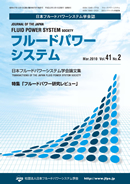All issues

Volume 41 (2010)
- Issue 6 Pages 107-
- Issue 5 Pages 85-
- Issue 4 Pages 67-
- Issue 3 Pages 43-
- Issue 2 Pages 21-
- Issue 1 Pages 1-
Volume 41, Issue 2
Displaying 1-3 of 3 articles from this issue
- |<
- <
- 1
- >
- >|
Paper
-
Hideki YANADA, Yamato KATOArticle type: Paper
2010 Volume 41 Issue 2 Pages 21-27
Published: 2010
Released on J-STAGE: May 16, 2013
JOURNAL FREE ACCESSThis paper deals with an improvement of filtration speed of an electrostatic oil filter. Commercially available electrostatic oil filters use a dielectric material such as paper as filter element. The filter element needs to be regularly exchanged to keep the filter performance and becomes waste after use. In order to minimize waste, reusable filter elements made of stainless steel are used in an electrostatic oil filter proposed. The effects of the configurations of the electrodes and filter elements on the electric and flow fields in the filter are numerically examined and three types of filter configuration are made based on the numerical simulation results. The effect of the filter configuration on the filtration speed is examined experimentally. The effect of the shape of the filter element on the filtration speed is also examined using one type of filter. It is shown that the filtration speed can be increased by making the flow velocity distribution in the filter uniform and an optimal filter configuration is proposed.View full abstractDownload PDF (1098K) -
Xuan Bo TRAN, Akinori MATSUI, Hideki YANADAArticle type: Paper
2010 Volume 41 Issue 2 Pages 28-35
Published: 2010
Released on J-STAGE: May 16, 2013
JOURNAL FREE ACCESSThis paper deals with the dynamic behaviors of friction observed in a hydraulic cylinder. Yanada and his coworkers have modified the LuGre model, which is the most widely utilized friction model, by incorporating lubricant film dynamics into the LuGre model and have shown that the dynamic friction behaviors of a hydraulic actuator can be simulated by the modified LuGre model with a relatively good accuracy. In addition, a method to identify the dynamic parameters included in the model has been proposed. However, the experiments were conducted using one type of oil at a fixed temperature. It has not been made clear how the dynamic behaviors of friction are affected by viscosity and type of oil. In this paper, the effects of the viscosity and type of oil on the dynamic behaviors of friction are examined using a hydraulic cylinder. It is shown that the type of oil affects the size of the hysteresis loop of the friction force-velocity curve to some degree and that the viscosity hardly has influence on the dynamic friction behaviors. It is also shown that the time constant of lubricant film dynamics is increased with increasing viscosity but its variation is relatively small and that the bristle stiffness and micro-viscous coefficient are not affected by the viscosity and the type of oil. A simple modification of the modified LuGre model taking the effects of the oil temperature into consideration is made. Comparisons between experimental and simulation results show that the improved model is appropriate.View full abstractDownload PDF (1236K) -
Zhen XIU, Canghai LIU, Ato KITAGAWA, Hideyuki TSUKAGOSHI, Kenichiro KO ...Article type: Paper
2010 Volume 41 Issue 2 Pages 36-42
Published: 2010
Released on J-STAGE: May 16, 2013
JOURNAL FREE ACCESSThis study focuses on an at-home wrist rehabilitation system aimed at achieving a situation where a home-stay patient can receive rehabilitation from a therapist in a clinic. In a former report, a pneumatic driven at-home wrist rehabilitation system, which could be used for passive exercise, was developed. Using the same system that was developed, this paper discusses the realization of rehabilitation by active exercise based on the wrist characteristics obtained in passive exercise. Firstly, game-based active-resistive exercise is proposed. Then game-based active assistive exercise using the wrist characteristics obtained in passive exercise to set up the assist torque is proposed. From the experimental results in the clinic, the validity of rehabilitation by active exercises developed in this paper is verified. From the above, it is clarified that both passive and active exercise could be carried on by the at-home wrist rehabilitation system developed in this research.View full abstractDownload PDF (1156K)
- |<
- <
- 1
- >
- >|